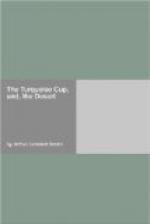“I do not understand,” said the cardinal.
“The turquoise cup,” repeated the earl. “The one in the treasury of St. Mark’s.”
The cardinal began to laugh—then he suddenly ceased, looked hard at the earl and asked, “Are you serious, my lord?”
“Very,” replied the earl.
“Are you quite well?” asked the cardinal.
“Yes,” said the earl, “but I am very uncomfortable.”
The cardinal began to pace up and down the balcony.
“My lord,” he asked, finally, “have you ever negotiated for the Holy Coat at Treves; for the breastplate of Charlemagne in the Louvre; for the Crown Jewels in the Tower?”
“No,” said the earl; “I have no use for them, but I very much need the turquoise cup.”
“Are you a professional or an amateur?” asked the cardinal, his eyes flashing, his lips twitching.
“As I understand it,” said the earl, slowly, a faint blush stealing into his cheeks, “an ‘amateur’ is a lover. If that is right, perhaps you had better put me down as an ‘amateur.’”
The cardinal saw the blush and his anger vanished.
“Ah,” he said, softly, “there is a woman, is there?”
“Yes,” replied the earl, “there is a woman.”
“Well,” said the cardinal, “I am listening.”
“It won’t bore you?” asked the earl. “If I begin about her I sha’n’t know when to stop.”
“My lord,” said the cardinal, “if there were no women there would be no priests. Our occupation would be gone. There was a time when men built churches, beautified them, and went to them. How is it now; even here in Venice, where art still exists, and where there is no bourse? I was speaking with a man only to-day—a man of affairs, one who buys and sells, who has agents in foreign lands and ships on the seas; a man who, in the old religious days, would have given a tenth of all his goods to the Church and would have found honor and contentment in the remainder; but he is bitten with this new-fangled belief of disbelief. He has a sneaking fear that Christianity has been supplanted by electricity and he worships Huxley rather than Christ crucified—Huxley!” and the cardinal threw up his hands. “Did ever a man die the easier because he had grovelled at the knees of Huxley? What did Huxley preach? The doctrine of despair. He was the Pope of protoplasm. He beat his wings against the bars of the unknowable. He set his finite mind the task of solving the infinite. A mere creature, he sought to fathom the mind of his creator. Read the lines upon his tomb, written by his wife—what do they teach? Nothing but ‘let us eat and drink, for to-morrow we die.’ If a man follows Huxley, then is he a fool if he does not give to this poor squeezed-lemon of a world another twist. If I believed there was nothing after this life, do you think I should be sitting here, feeding the pigeons? Do you think—but there, I have aired my English speech and have had my fling at Huxley. Let me fill your cup and then tell me of this woman whom I have kept waiting all this time by my vanity and my ill manners. Is she English, French, Spanish, or American? There are many Americans nowadays.”




